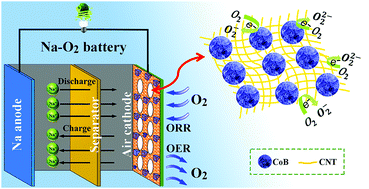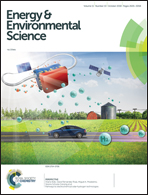Synthesis of porous and metallic CoB nanosheets towards a highly efficient electrocatalyst for rechargeable Na–O2 batteries†
Abstract
The sodium–oxygen (Na–O2) battery is proposed as one of the most promising energy storage technologies due to its high energy density and the abundance of sodium resources; however, its applications still suffer from low energy efficiency and poor cycle stability and rate performance due to the absence of highly efficient electrocatalysts. Herein, as a proof-of-concept experiment, we, for the first time, develop a facile and solid-state reaction strategy for controllable synthesis of porous cobalt boride (CoB) nanosheets with the help of inorganic molten salts. Surprisingly, when CoB nanosheets are employed as cathode catalysts for Na–O2 batteries for the first time, significantly improved electrochemical performances are obtained, such as a low charge overpotential, good rate capability, and a high specific capacity (11 482 mA h g−1) and cycle life (74 cycles), which, in combination with density functional theory, could be attributed to the synergy of high catalytic activity and electronic conductivity and the porous sheet structure of CoB. This experimentally and theoretically established metallic transition metal borides as intriguing electrocatalysts could trigger more studies on other energy storage and conversion systems.



 Please wait while we load your content...
Please wait while we load your content...